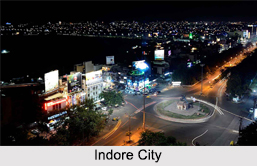 Indore is a major commercial city of central Indian state of Madhya Pradesh. Indore played a most important role in history of India. Indore has the secondary and tertiary industries and has a good connectivity with all the Indian states and the cities of India.
Indore is a major commercial city of central Indian state of Madhya Pradesh. Indore played a most important role in history of India. Indore has the secondary and tertiary industries and has a good connectivity with all the Indian states and the cities of India.
Location of Indore
Indore is located in Indore District of Madhya Pradesh. Indore touches the southern edge of Malwa plateau and it is surrounded with Saravati river and Khan river. These are the tributaries of Shipra river. Indore is located on the elevated plain of Yadri range in the south of India.
History of Indore
Indore rose into prominence with the arrival of British. Previously, it was an integral part of Marathas, and after the Anglo- Maratha War, British began to rule and Holkar Dynasty (Maratha wing) began to diminish from the entire Malwa region. British made Indore the Princely State of India and Holkar became the feudal lords. From 1906, Indore saw the developments by establishing the railway lines, electric machinery and the small scale industries. After Independence of India in 1947, Princely State of Indore merged with Government of India and Indore became the capital city of Madhya Bharat.
Geography of Indore
 Indore is located on the western side of capital city of Madhya Pradesh-Bhopal. Indore covers an area of 3898 sq km. The latitudinal location of the city is between 22.42 degree north and 75.54 degree east with an altitude of 553metres from sea level.
Indore is located on the western side of capital city of Madhya Pradesh-Bhopal. Indore covers an area of 3898 sq km. The latitudinal location of the city is between 22.42 degree north and 75.54 degree east with an altitude of 553metres from sea level.
Climate of Indore
Indore enjoys a transitional weather which varies from tropical wet and dry climate to humid subtropical climate. The summer temperature rises from 44 degree Celsius to 48 degree Celsius and the cool temperature varies from 26 degree Celsius.
Demography of Indore
According to the Population Census in the year 2011, Indore has the total population of about 2,170,295. The average literacy rate is about 87.38 percent. Hindi Language is the official language of Indore.
Economy of Indore
Indore is economically flourished with manufacturing industries, logistic, gemstone and Information Technology industries.
Culture of Indore
Indore is culturally enriched with the mixed cultures of Maharashtra and Bundelkhand.
Indore celebrates the festivals like Holi, Rangpanchmi, Baisakhi, Raksha Bandhan, Navratri, Dussehra, Ganesh Chaturthi, Deepavali, Ramzan, Gudi Padwa, Bhaubeej, Eid, Christmas Nagpanchmi and Ahilya Utsav. Indore is also known for its cuisines like Namkeens, Poha and Jalebi, Chaats (snacks), Kachoris and Samosas.
Tourism in Indore
Indore is dotted with many tourism destinations like Atal Bihari Vajpayee Regional Park, Kamla Nehru Prani Sangrahalay, Rajwada Palace and Yeshwant Club.



















